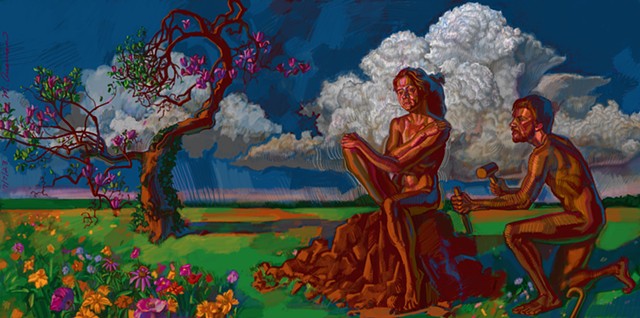Digital Paintings
* To enlarge, click over the image's upper right corner *
* For commentary about this painting, scroll down *
The Greek primordial element Chaos and his immaculately conceived progeny Nyx and Erebos inspired my digital works "Sunflowers in Moonlight," "Hemera," "In These Metal Days," "Ether," "Foam," "Form," and "Format." "Equal Parts Earth and Water" explores the ancient Greek creation stories of Womankind, Pandora, and Pygmalion: All were conceived first as works of art and secondly as scions, entities, and beings. Hesiod writes about the creation of Womankind in "Theogony." In his "Works and Days," he repeats this story in greater detail but refers to the female as Pandora--not as "Woman" as he does in "Theogony." In both stories, Hephaistos sculpts them per Zeus's command.
Naughty Prometheus gave mortals fire, disobeying Zeus's order. Zeus duly punished Prometheus but concocted a separate punishment for mortals: "Woman." Zeus commanded Hephaistos to create "from equal parts earth and water" a "modest maiden" yet "snare of Men." (Quotations from my translation of "Theogony"). Although Hesiod and Pygmalion equivocate about Woman's role as a positive or negative force on humanity, I think we mortals can interpret these stories more positively: Perhaps as an examination and commentary about natural and inevitable conflict and misunderstanding between the sexes? Or perhaps as more an examination/judgment of Mankind than of Womankind? Or perhaps as a metaphor about how all art and all creation are alive because they strive to unite the sense-perceptual world and life processes with soul and spiritual processes--not only in a teleological sense? Simultaneously revealing and concealing mysteries about existence and being?
This story reminds me of other creation stories, in which the male creates the Woman, either from his own body or as an artist. Hephaistos and Pygmalion create Woman using external materials and are artists. God, the ultimate artist, creates Woman--i.e. Eve, from Adam's body.
In "Equal Parts Earth and Water" I expand upon my mark-making systems, using broad areas of tone, flat shapes, and distinct shape-planes in addition to my chaotic and cross contour line work. (For more about these systems, see my written explanation of my formal approach to my digital works under "Digital Drawings/Paintings).
Under a spell of contradictory feelings of loathing and worship, Zeus, Hephaistos, and Pygmalion sculpt their Woman. Hephaistos carries out the actual creative activity while Zeus billows in the background threateningly. The clay is red like the soil of my home The Piedmont of North Carolina and is a reference to Red-Clay Figure-Painting on ancient Greek pottery. (I hope this reference conjures connections between these otherwise two seemingly disparate cultures, places, and time periods). Hephaistos is in the final stages of his creation, chasing the hardened clay with a hammer and chisel. Later in the story, Athena enters to make a garland of wildflowers for Pandora's head and to attire her in alluring finery.
